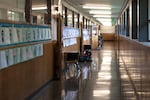With just two weeks until Oregon schools are expected to reopen for elementary students, the Oregon Department of Education has released new guidance for schools to follow. The guidance follows an announcement and executive order from Oregon Gov. Kate Brown that elementary schools resume in-person instruction by March 29 and middle and high schools resume doing so by April 19.
The new changes include removing a limit on the number of people a single student can interact with at school. That limit had been set at 100 people per week.
ODE still recommends student cohorts of no more than 36 students.
The state’s guidance also maintains a requirement of at least 35 square feet per person when it comes to room capacity.

Empty school hallways may soon be busy again starting in April.
Rob Manning / OPB
People are still advised to stay six feet apart, especially inside school buildings, in following recommendations from the Centers for Disease Control and Prevention.
There have been local and national conversations about whether that recommendation should be amended.
Other changes include a removal of a recommendation for 360-degree cameras in the classroom and an updated list of high-risk populations.
On-site screening for COVID-19 symptoms remains required for elementary students, but screening for middle and high school students can happen off-site, before students get to school. Screening typically happens visually or by asking about symptoms or whether students have had close contact with someone with COVID-19.
The guidance offers some flexibility to schools in reopening dates if they’ve already communicated a plan to families and set aside time for staff training.
This allows a school district like Beaverton to continue its planned April 5 reopening date for younger students. Portland Public Schools is also anticipating an April 5 return for upper elementary students, based on a tentative agreement reached early Monday morning with the teachers union.
For families that choose to remain in comprehensive distance learning, schools must provide that option.
“The school or district may determine the most beneficial way to staff this option, through partnership with other schools or [Education Service Districts] or with staff who may be at more risk from COVID-19 or through other means,” according to page 13 of the document.
The guidance is meant to align with Brown’s executive order requiring schools to operate in either an onsite or hybrid instructional model by the middle of April.
Schools who do not meet these requirements may lose their eligibility to receive state school funds.
